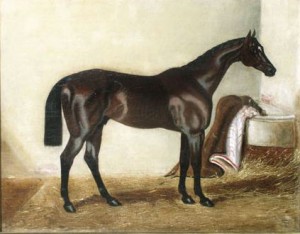For Thursday Art-Day we look at Frederick Woodhouse
Frederick Woodhouse was sporting and livestock painter. He was born in Hadley near Barnet, Essex, on 26 December 1820. Both his father, Samuel Woodhouse, and his uncle, John Thomas Woodhouse, were painters. In May 1858 accompanied by his wife Mary and their four sons they arrived in Melbourne, Victoria as assisted migrants on the Parsee. Two other sons were born in Australia. The pre-eminent sporting artist of his time, Woodhouse became best known for painting every Melbourne Cup winner for more than thirty years, from the first in 1861. During a long, and successful career, he visited New South Wales, Tasmania, South Australia and Western Australia and documented much Australian racing and rural history. He worked mainly in oils, usually on canvas but quite often on board.  He painted champion racehorses, show-horses, Clydesdales, trotters, hunters, greyhounds, cattle and sheep as well as hunting, coursing and fishing scenes, landscapes and narrative works.
He painted champion racehorses, show-horses, Clydesdales, trotters, hunters, greyhounds, cattle and sheep as well as hunting, coursing and fishing scenes, landscapes and narrative works.
A foundation member and councillor of the Victorian Academy of Arts, Woodhouse exhibited in 1870, 1872 and 1873; he resigned as a member in 1877. His oil painting The Smithy, for sale at 25 guineas, was included in the category of ‘Historical Picture, or Tableau de Genre’ at the 1870 Sydney Intercolonial Exhibition. During the 1870s illustrations after Woodhouse’s paintings were reproduced as both engravings and photographs in horse and cattle sale catalogues and early stud-books.
Top Photograph: Rajah, an Arab stallion with his groom, Thombo
You could find his work in illustrated newspapers such as the Australasian Sketcher and the Town and Country Journal. He initiated a series of Australian sporting prints, Woodhouse’s Australasian [sometimes Australian] Winners, which continued until 1900. Most of the lithographs were drawn by his son Frederick junior and one by another son, Edwin. Woodhouse also designed racing, steeplechasing, coursing and other sporting trophies including the Victoria Gold Cup awarded for the principal race at the first meeting of the Victoria Amateur Turf Club in 1876. He had five paintings in the London Colonial and Indian Exhibition in 1886. With his son Herbert, he wrote, illustrated and published A Record of the Melbourne Cup in 1889; in December 1892 they held a joint exhibition at Scott’s Hotel, Collins Street, Melbourne.
 Frederick Woodhouse died at the age of eighty-nine. He painted right up until the end of his life sending paintings to the Yarra Sculptors’ Society exhibitions in 1904, 1906 and 1908. He died at Melbourne on 29 December 1909, survived by his second wife and five of the six sons from his first marriage, four of whom were also painters.
Frederick Woodhouse died at the age of eighty-nine. He painted right up until the end of his life sending paintings to the Yarra Sculptors’ Society exhibitions in 1904, 1906 and 1908. He died at Melbourne on 29 December 1909, survived by his second wife and five of the six sons from his first marriage, four of whom were also painters.
Bottom Photograph: ‘Melbourne’ winner 1875 Geelong Cup
Adapted from an article by Colin Laverty. Author of : ‘Australian Colonial sporting painters : Frederick Woodhouse and sons’ by Colin Laverty
One Response
Tweets that mention For Thursday Art-Day we look at Frederick Woodhouse | carmelrowley.com.au -- Topsy.com
[…] This post was mentioned on Twitter by Carmel Rowley, Carmel Rowley. Carmel Rowley said: For Thursday Art-Day we look at Frederick Woodhouse http://t.co/lzaCkok via @CarmelLRowley […]